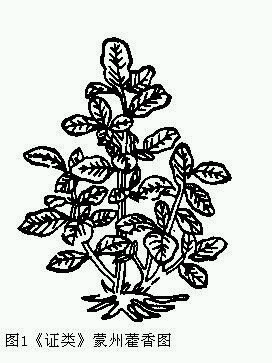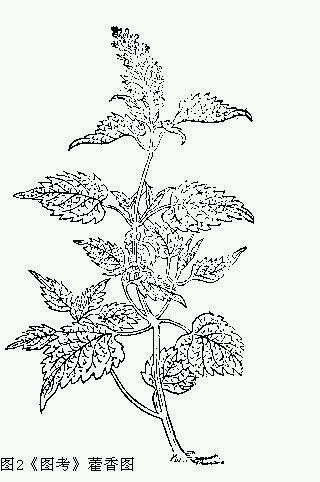| title | Patchouli |
| release time | 2006/6/6 |
| source | Jade Knock Studio |
| keyword | Patchouli |
Patchouli is the dried aerial part of the plant Pogostemon cablin (Blanco) Benth. of the Lamiaceae family. Patchouli is mainly cultivated, and commercial medicinal materials are divided by origin into Shipai Xiang, also known as Pai Xiang or Zheng Xiang, mainly produced in Shipai, Guangdong; Gaoyao Xiang, also known as Zhao Xiang or Zhi Xiang, mainly produced in Gaoyao County, Zhaoqing City; Zhan Xiang, mainly produced in Zhanjiang, Suixi, and Xuwen; Nan Xiang, mainly produced in Hainan. Among these, Shipai Xiang is of the best quality. In addition to Guangdong and Hainan, it is also cultivated in Guangxi, Fujian, Taiwan, Sichuan, Yunnan, and Guizhou.
Materia medica research suggests that Pogostemon cablin of the Lamiaceae family is native to Southeast Asia and was imported as a spice around the Han and Wei periods, being the authentic source of "Patchouli." This plant began to be cultivated on a large scale in Lingnan during the Song Dynasty. By the late stage of the Ming Dynasty, the widely distributed wild Lamiaceae plant Agastache rugosa began to be used as a substitute for Pogostemon cablin, which was then forced to be renamed "patchouli" to distinguish it. From the perspective of cultivation history, Guangdong has always been the authentic production area of patchouli.
bubble_chart Varietal Examination
The large-scale import of ancient plant-based spices is likely related to the Buddhist practice of using various incenses for offerings. Among these incenses, Patchouli was also commonly used. For example, in the "Mahāratnakūṭa Sūtra" Volume 5, a recipe for burning incense uses twelve types of incense, the first being Patchouli, known in Sanskrit as "Patala incense." Additionally, on the eighth day of the fourth lunar month, during the Buddha Bathing Festival, the water is prepared by steeping three types of herbal incense: Duliang Xiang, Patchouli, and Aina Xiang, as recorded in the "Fayuan Zhulin" Volume 33. Moreover, in various scriptures, "Douloupo Xiang," "Duomoluoba Xiang," and "Jiasuan Xiang" are all considered to be Patchouli. Since Patchouli mainly came from foreign countries, early literature contains many errors in describing its plant characteristics. A typical example is the statement by Yu Yiqi and Han Kangbo during the Eastern Jin Dynasty: "Foreign elders say that all incenses come from a single large tree: the flowers are cloves, the resin is frankincense, the nodes are green wood, the roots are sandalwood, the leaves are Patchouli, and the heartwood is agarwood."
These errors were gradually corrected with increased exchanges. According to the "Fayuan Zhulin" Volume 36, the "Guang Zhi" states: "Patchouli comes from the southern countries." The "Wu Shi Wai Guo Zhuan" says: "Dukun is in Funan and produces Patchouli." The "Nanzhou Yiwu Zhi" notes: "Patchouli comes from Diansun, a coastal country belonging to Funan. The incense resembles Duliang and can be placed in clothing." Additionally, the "Taiping Yulan" Volume 982 quotes the "Nanfang Caomu Zhuang": "Patchouli grows in clusters, cultivated by the people, harvested in the fifth and sixth months, and dried to become fragrant. It comes from Jiaozhi, Wuping, Xinggu, and Jiuzhou." The "Jiaozhou Ji" states: "Patchouli resembles Storax." (Note: The "Yiwen Leiju" Volume 81 quotes it as "Patchouli resembles Su." Li Shizhen comments: "Liu Xinqi's 'Jiaozhou Ji' says Patchouli resembles Storax in terms of its aroma, not its shape.") Furthermore, Du You's "Tongdian" also mentions: "Dunsun produces Patchouli, which grows when cuttings are planted." From these records, it is evident that Jiaozhou is near Vietnam, Diansun is also known as Dunsun, and Dukun is also called Dujun, all located in the Malay Peninsula. This indicates that the Patchouli used in ancient times was first introduced from countries such as Vietnam, the Philippines, and Malaysia.In early times, Patchouli was mainly used as a fragrance for scenting clothes or as a powder for external use. Volume 6 of Zhouhou Fang contains a secret recipe for treating armpit odor: "Take two taels each of slender dutchman's pipe root, Patchouli, clove, and lead-powder. Grind these four ingredients into a powder, apply it under the armpits, and wrap it with cotton. This will often cure the condition." The same volume also includes a six-ingredient formula for scenting clothes: "Take one piece of Aquilaria, one tael of musk, Storax coated with honey and lightly roasted until it slightly changes color, and one tael of beautiful steetgum resin. Crush the Aquilaria into pieces the size of soybeans, and separately crush one tael of clove into three or four segments. After grinding the remaining fragrances, mix them with honey to form sticks, which can be burned. For scenting clothes, use about half a tael. Another version adds one tael of Patchouli, which is excellent." This is what is referred to in the "Nan Zhou Yi Wu Zhi" as "placing it within clothes." Tao Hong-jing's Mingyi Bielu, likely influenced by Yu Yiqi's claim that five fragrances come from one tree, appended Patchouli to the entry for Aquilaria in the superior category of the wood section, mentioning only its efficacy in treating "cholera heart pain." The Xinxiu Bencao followed this, but the Song dynasty's "Jia You Materia Medica" finally separated it and added its efficacy: "Treats wind edema and swelling toxins, and removes malign qi." However, it was still classified under the wood section until the Ming dynasty's Bencao Pinhui Jingyao moved it to the upper category of the inferior herbs in the grass section.
The large-scale cultivation of Patchouli in China should have started in the Song Dynasty. The Bencao Tujing states: "Patchouli was previously attached to the five fragrances section, without mentioning the region of origin. Nowadays, it is abundant in the Lingnan region, and many households also cultivate it. It sprouts in February, with dense stems and clusters, leaves resembling mulberry but smaller and thinner. It is harvested and dried in June and July, becoming fragrant, and can be collected once it turns yellow." According to the Zhenglei Bencao's illustration of Mengzhou Patchouli (Figure 1), the variety should be the Pogostemon cablin used today.In ancient times, only the leaves of Patchouli were used for medicinal purposes. The Bencao Gangmu states: "Patchouli has square stems with nodes and hollow centers, leaves slightly resembling eggplant leaves. Jiegu and Dongyuan only used the leaves, not the stems, but nowadays people use both stems and leaves because the leaves are often counterfeit." Upon examining the Taiping Huimin Heji Jufang and the "Chuanxin Shiyong Fang," it is indeed common to find references to "Patchouli leaves," with instructions to "remove sand, soil, and stems." The Bencao Mengquan also mentions: "In the Lingnan region, many people cultivate it, harvesting in July when it is very fragrant. Vendors often mix in cotton leaves and eggplant leaves as counterfeits, so one must be careful in selection. Remove the stems for medicinal use, specifically treating the spleen and lung meridians." It is thus understood that later generations used the entire above-ground part of the plant to prevent counterfeiting.
At that time, not only were leaves of other plants used to counterfeit Patchouli, but various aromatic plants were also mixed and called "Patchouli." The Diannan Bencao mentions "Tu Patchouli," used to treat stomach heat and children's ulcerative gingivitis. The compilers identified the original plant as Agastache rugosa (Fisch. et Mey.) O. Kuntze of the Lamiaceae family. This plant was misused under the name Patchouli in the late Ming Dynasty. The "Materia Medica Chengya Banji" states: "Patchouli comes from Jiaozhi, Jiuzhen, Wuping, Xinggu, and other regions, where officials and commoners cultivate it. Nowadays, it is abundant in Lingnan and can be found elsewhere. In February, the perennial roots sprout again, and it can also be grown from seeds. The seedlings resemble Duliang, with square stems growing in clusters, hollow centers, and external nodes. The leaves resemble Perilla, with serrated edges. In July, it produces spikes, flowers resembling knotweed, seed pods resembling false perilla, and seeds resembling Leonurus. The stems and leaves are harvested and dried in May and June before the spikes emerge." The Bencao Huiyan is similar. The Pogostemon cablin cultivated domestically rarely flowers and bears fruit, mainly propagated through cuttings. Thus, the Patchouli described by Lu Zhi-yi and Ni Zhu-mo, with leaves resembling Perilla and flowering spikes, is actually Agastache rugosa. However, at that time, it was no longer called "Tu Patchouli" but simply "Patchouli."
Agastache rugosa may have been the mainstream medicinal Patchouli in the Qing Dynasty. Not only did most materia medica follow the descriptions in the "Materia Medica Chengya Banji," but the Zhiwu Mingshi Tukao, Volume 25, also states: "Patchouli is mentioned in the 'Southern Flora,' and was first recorded in the 'Jiayou Materia Medica.' Nowadays, it is widely cultivated in Jiangxi and Hunan. It is a good medicine for preventing heatstroke, as it can treat spleen and stomach vomiting and is essential for combating cholera." According to the attached illustration (Figure 2), it is also Agastache rugosa. Since Agastache rugosa occupied the name Patchouli in the Qing Dynasty, the Pogostemon cablin produced in Guangdong was forced to be called "patchouli" to distinguish it.

bubble_chart Historical Evolution of Authentic Herbs
As mentioned earlier, patchouli was introduced to China from Southeast Asian countries between the Han and Wei dynasties. Initially, only its leaves were used, and it was mistakenly believed to be the leaves of a tree, leading to records of "five fragrances from one tree." Later, as cultivation succeeded, understanding of this plant gradually increased. Regarding the time of patchouli's introduction to China, Mr. Xie Zongwan's "Discussions on Chinese Medicinal Varieties" mentions that the "Guang Zhi" from the Liang Dynasty states "it is abundant in Lingnan," thus suggesting that "patchouli had been cultivated in China at least before the Liang Dynasty." However, upon reviewing various encyclopedias citing "Guang Zhi," all state that "patchouli comes from the countries south of the sun," not mentioning its growth in Lingnan. Moreover, Tang Dynasty materia medica still mistakenly considered patchouli to be a woody plant, indicating that it was not widely cultivated at that time. Therefore, the introduction of patchouli to Lingnan should be dated to the Song Dynasty, as stated in the "Tu Jing." Additionally, the "Zheng Lei" includes a medicinal illustration of patchouli from Mengzhou, which is present-day Mengshan County in Guangxi, indicating that patchouli cultivation during the Song Dynasty extended beyond Guangdong to include Guangxi.
The records of Chen Renshan and Cao Bingzhang from the Republic of China period provide insights into the production of patchouli. The "Compendium of Medicinal Products" states: "Patchouli is produced in Guangdong, with the best quality coming from Panyu, Henan Baogang, Namo Village, and Shipai. Zhaoqing and Liubu produce Zhao Xiang, which is of secondary quality. The patchouli produced in the Qiongzhou region is known as Nan Xiang and is of even lesser quality." The "Revised Weiyao Tiaobian" states: "Patchouli, known as 'Douloupo Xiang' in materia medica, is most authentic when produced in Lingnan. Within a hundred miles of Yangcheng, the patchouli from Henan Baogang Village and Zhaoqing, which is harvested in May and June, has square stems, white hairs, and green leaves. When rubbed, it emits a strong, fragrant aroma. The variety with a slightly pungent and mild taste is called patchouli. The most authentic patchouli is collected and distributed by major trading houses in the provincial capital of Guangdong, with Juchang and Taichang being the most renowned. Patchouli from Leizhou and Qiongzhou is known as Hainan Patchouli, which is now referred to as 'foreign patchouli.' It has a weaker and more turbid aroma, a pungent and harsh taste, smaller and finer leaves, round stems, and long roots, making it the lowest quality. Other varieties, such as the local patchouli produced in Jiangsu and Zhejiang, can be sliced fresh and dried under intense sunlight. Stored in jars, it retains its fragrance and is highly effective in medicinal use, not inferior to patchouli."
bubble_chart Other Related Items




